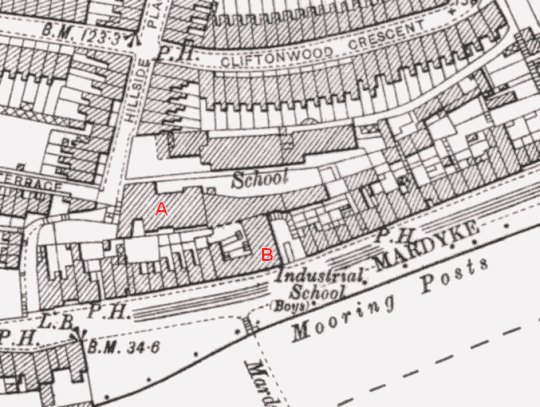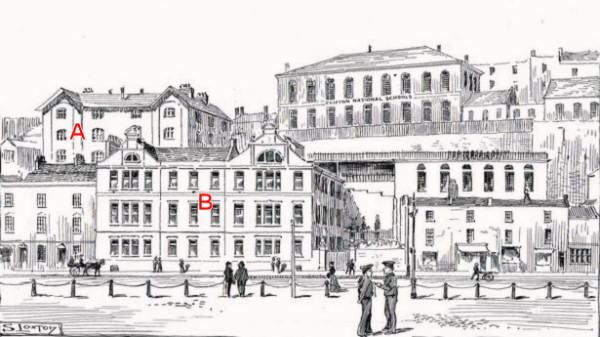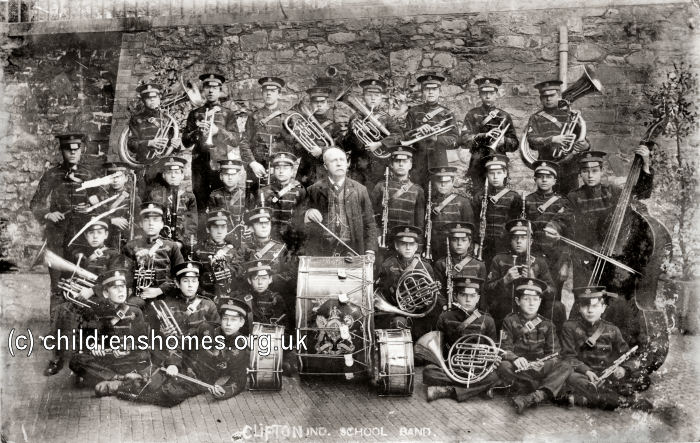Clifton Industrial School for Boys, Bristol, Gloucestershire
The Clifton Industrial School for Boys (also known as the Bristol and Clifton Industrial School) was established in 1849 and occupied the former premises of the St Philip and St Jacob parish workhouse on Pennywell Lane (now Road), Bristol. On May 7th, 1859, the institution was certified as an Industrial School, allowing it to receive boys committed by magistrates to a period of detention.
In 1866, after part of its site was required for the building of a cholera hospital, the School moved to larger premises at Thorns Building, Church Path Steps, Clifton Wood — the building had previously served as the Clifton parish workhouse. On October 23rd of that year, the establishment was re-certified with accommodation of 175 boys, aged 10 to 14 years at their time of admission. The then superintendent and matron, William and Elizabeth Hibbins, continued in their posts at the new location.
In addition to their classroom lessons, the boys were employed in tailoring, shoemaking and brush-making, with basket making later added. The boys also assisted with the kitchen, laundry, and house work. In 1870, some additional rooms were rented in the locality for use as an infirmary if required. A School band was established.
The following account of the School appeared in 1870, when it contained 100 boys:
The school premises are situated close to the river at Bristol, in a busy part of the town, and are somewhat cramped for room. They are conducted on the half-time system entirely, and receive children from the city of Bristol and county of Gloucester, together with some from Stafford.
The industrial work pursued is— 1. Tailoring. 2. Shoemaking. 3. Brushmaking. 4. Laundry-work.
In all these branches a considerable profit is made, after deducting the whole cost of material and tools, and likewise the wages of the teacher. Forty boys are employed in the tailoring trade, and they make the whole of the clothes for the school, as also the uniforms for the volunteer band. The net profit in this branch last year was 96l. 18s. 5d. In shoemaking eighteen boys were instructed, and produced boots and shoes for the school, at a profit of 30l. 2s. 7d., that is to say, had these articles been purchased, they would have cost that sum over and above the outlay on the materials and the wages of the teachers. The brushmaking business is conducted somewhat differently, as, of course, the manufactured articles are of no use to the school. It is the practice for a manufacturer to send the materials, and for the boys to make them into the style of brush required. By this means the school runs no risk, and ample employment is given to the boys at a remunerative rate. During the year, a sum of 116l. 9s. 4d. was paid for making brushes, which yielded a profit of 76l. 2s. to the institution. The laundry is also considered an industrial department, as indeed it is; and since this work has been done by the boys themselves, a large saving has been effected, besides useful work being found for the children. The profit for last year was 29l. 4s. From this it appears that the total net profit to the funds of the school accruing from the industrial departments, in the year 1868, was 228l. 11s. 5d., or considerably over 11 per cent. of the entire cost of the institution.
This great success may be partly accounted for from the excellent plan of giving the children themselves an interest in their work. In all cases part of the profit goes to the boy, that is,on the number of articles he has produced; the earnings, therefore, of each are strictly on results. The money thus earned is deposited in the savings-bank, and on the boy leaving, it is given to him to help as a start in life. Several, by this means, have accumulated 4l. or 5l.
Six of the most deserving boys received their freedom on licence during last year; and, up to the present time, the managers report that in only one instance since the licence system was introduced has the privilege been abused.
A drum and fife band has been formed, composed of the children of the school, and its efficiency is so well known that on several occasions urgent requests have been made for the loan of it at fêtes, &c. The managers, however, wisely think that it is hardly advisable to allow the boys to go out for such occasions, when they would be removed from the eye of their officers, and liable to get into mischief. For school purposes, that is, for maintaining the tone and life of the children, as also in assisting in the systematic drill which is carried on, the superintendent considers that, with such children, a band is an essential means of instruction and improvement.
The subjects of education, apart from industrial training, are necessarily elementary, the three ‘R’s’ being about all that is expected, the rules of the committee stating that other subjects may be added, as the limited time and capacities of the boys may warrant. In a few cases, when any child shows a superior amount of intelligence, the course may be somewhat extended, though the principal object of the school is the industrial training of the boys, in order to form habits of labour, neatness, order, and general usefulness.
The punishments necessary to maintain discipline are left to the superintendent, though he is required to report them to the committee. During 1868, thirty-six were inflicted, consisting of forfeiture of rewards and privileges, reduction of food, separate confinement, and, for the severest offences, moderate personal correction with a common school rod or cane.
The expenses of the school are rather high, amounting to 2,051l. 13s. 9d. for the year 1868, or at the rate of 20l. 10s. per head. It is true that the profits on industrial work reduce this by 2l. 5s., but still there can be no doubt that even then it is too high. Under the excellent management in which the school now is, it would seem probable that were the size of the school increased the cost would relatively be much reduced. Within a very short distance of this institution there are two others precisely similar, the one at Park Row, for sixty-nine boys, and the other at Cotham Road, for twenty-eight girls, each requiring the expense of a separate staff, rental, &c. This might be much reduced, besides being made more efficient, by uniting all three together.
The results of the training on the children in their after life are certainly satisfactory, though the fruits do not seem to be so great as at the large pauper schools of Norwood, &c. This may probably be accounted for from the fact that the average age of the children on entering being greater at Clifton than at Hanwell, they have, unfortunately, in too many cases, had the seeds of crime profitably sown in them by their companions before entering the institution. The number, however, who are permanently rescued from a life of villainy is very great, being not less than 80 to 85 per cent. From a return made of those who left this school in the years 1865, 1866, and 1867, it appeared that 31 were doing well; 5 were doubtful; 4 had been committed to prison; 1 to a reformatory; 3 had disappeared; two were dead; total 46. Of the five doubtful cases, and the three who had disappeared, the larger number subsequently were found to be doing well, so that really only five of the forty-six were known to have been trained in vain.
On June 7th, 1890, Mr and Mrs Frank Lewis Lord took over as superintendent and matron. Miss M.E. Howell took over as matron on August 8th, 1910. Other staff now included the Head schoolmaster, Mr J.E. Wilshaw; Assistant schoolmasters, Mr F.A. Ryall and Mr A.E. Crew; a drill and gymnastic instructor, tailor, shoemaker, carpenter and manual instructor, visiting bandmaster, yardmaster, cook, needlewoman, laundress, and dormitory matron.
By 1896, the School had expanded into a new building known as Mardyke House which stood close by on Mardyke (now Hotwell Road) and provided a large workshop, dormitory, and school room. In the same year it was reported that the usual distribution of work amongst the boys was as follows: tailoring, 30; shoemaking, 18; binding and lining tool-baskets in tailor's shop, 18; carpenters (general repairs etc.), 12; brushmakers (for one firm which supplied the materials), 69; patten-makers (mostly in the winter), 4; knitting and mending (younger boys under seamstress), 20; stokers, 2; house, laundry, &c., 27. Boys were passed on from housework to a trade within 12 months, unless in training as a page boy. The brass and reed band now comprised 28 performers under the charge of the second schoolmaster. The School had no playing field, but the boys were taken out to the Durdham Downs twice a week for football and cricket. The School's swimming bath was large enough for the boys to learn in, and about 80 a year succeed in doing so. Musical drill with dumb-bells and wands was carried out daily. There were generally four outings in the course of the summer, and occasional visits were made to local entertainments, A magic lantern was used frequently in the winter, and entertainments were got up by the boys, and also by friends of the School. There was a library of 400 books, which were largely read in the winter. Indoor games are also supplied. Boys of good conduct were allowed leave of up to 8 days to visit their homes, if suitable, twice a year.
The School's two sites are shown on the 1902 map below. The Church Path Steps building is marked 'A' and the Mardyke building 'B'.

Clifton Industrial School for Boys site, c.1902.

Clifton Industrial School for Boys from Mardyke.

Clifton Industrial School band, early 1900s.
A mark system was introduced into the School where good conduct earned a monetary reward, part of which was banked and the rest being allowed to be spent on a treat. Leave and other privileges were also dependent on the mark system.
The School eventually operated entirely in Mardyke House and became known as Mardyke House School. Due to falling numbers, the School was formally closed on August 8th, 1924. The remaining inmates joined the National Nautical School at Portishead.
The Clifton Wood School buildings were destroyed during the Second World War.
Records
Note: many repositories impose a closure period of up to 100 years for records identifying individuals. Before travelling a long distance, always check that the records you want to consult will be available.
- Bristol Record Office, 'B' Bond Warehouse (in the 'Create Centre' section from 3-Dec-2013), Smeaton Road, Bristol BS1 6XN. Some records covering both Clifton and Portishead. Holdings include Annual Reports (1847-1898); Registers of Boys (1872-1931); Discharge and Licence Records (1918-1964); Staff salaries (1915-25); Staff wages (1919-1924).
Census
Bibliography
- Higginbotham, Peter Children's Homes: A History of Institutional Care for Britain's Young (2017, Pen & Sword)
- Mahood, Linda Policing Gender, Class and Family: Britain, 1850-1940 (1995, Univeristy of Alberta Press)
- Prahms, Wendy Newcastle Ragged and Industrial School (2006, The History Press)
Links
- None noted at present.
Except where indicated, this page () © Peter Higginbotham. Contents may not be reproduced without permission.


